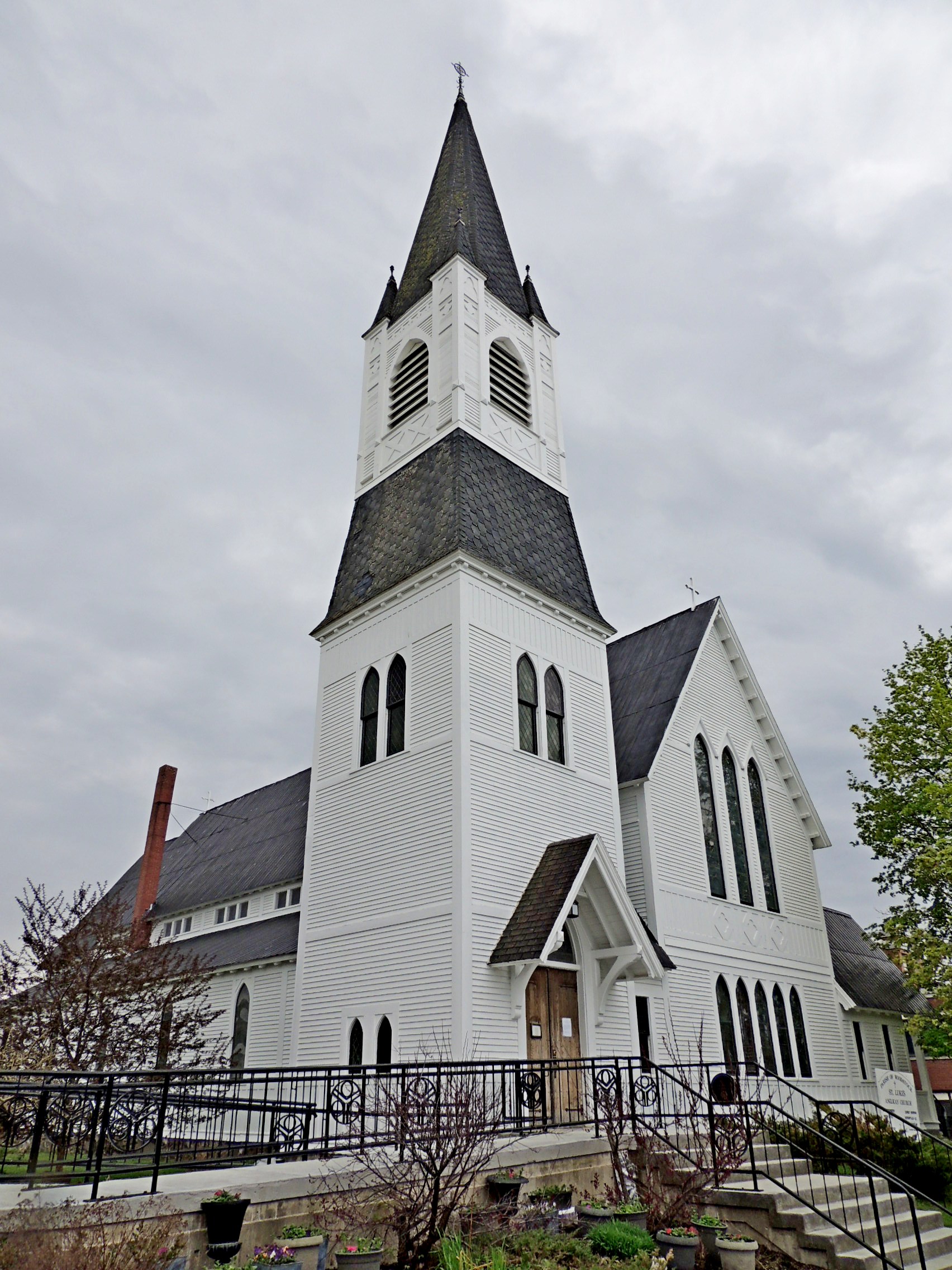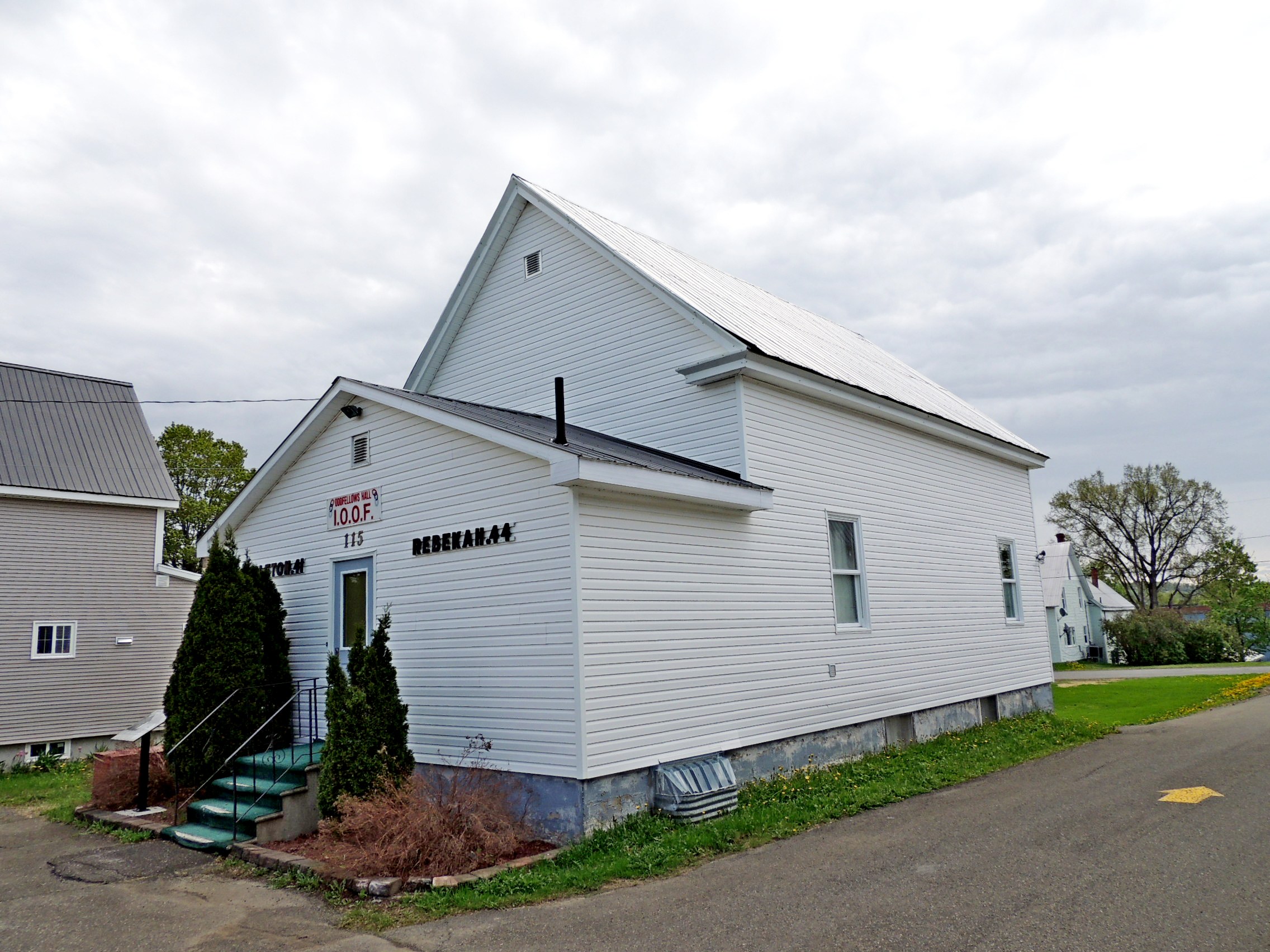One of the stops on the tour is the
Honourable Charles Connell House, a National Historic Site, built in 1839 for businessman and politician Charles Connell. Now the home of the
Carleton County Historical Society and the Connell House Museum, it is there one wants to go if they wish to pick up a copy of the brochure for this tour.
The walking tour will take one around central Woodstock, with 42 stops along the way. The tour passes essentially all the historic homes, commercial and civic buildings in the town. Following are some of the highlights of the tour, in the order in which they will be encountered, taken from the
Heritage Walking Tour Brochure.
 ST. LUKE’S ANGLICAN CHURCH
ST. LUKE’S ANGLICAN CHURCH
Completed in 1884, St. Luke’s Anglican Church in the third Anglican Church to be erected on this site, its uncompleted predecessor having been destroyed by the Woodstock fire of 1881. he first church was erected on this site as early as the 1830s.
St. Luke’s Anglican Church is an example of ecclesiastical carpenter Gothic architecture.Ris style is evident in the central tower on the front facade and the Gothic arch windows.Re exterior is in original form with the exception of a recently added access ramp. Inside, the sanctuary has undergone only minor modifications, electric lighting and additional stained glass windows. The exterior décor, including the woodwork and spatial configuration, remains intact.
 CARLETON COUNTY COURTHOUSE
CARLETON COUNTY COURTHOUSE
The court house was built in two phases 25 years apart. The lower half, completed in 1889, was designed by architect J.G. Fletcher to house the Records office. The upper half, its cornerstone laid on July 31, 1909, became the County Court House, initiating the relocation of all county buildings to Woodstock and thus ending the Town’s longstanding feud with Upper Woodstock.
The Romanesque Revival character defining elements that describe the building include: 2 full stories; the broad hipped roof; the three hipped roof dormers; the red brick exterior; the brick cornice; the pavilions at the main entrances; the decorative rusticated sandstone elements including the Romanesque arches over the main entrances and the windows, lentils and string courses and the decorative carved sandstone elements including the Corinthian leaves and the small animals. On the grounds, the cenotaph, a statue of a WWI soldier, was constructed in the early 1920s.The names of Carleton County WWI
casualties are inscribed on its base. Casualties after WWI are added on the bronze plaques.
 WOODSTOCK BAPTIST CHURCH
WOODSTOCK BAPTIST CHURCH
Although the history of the Baptist denomination in Woodstock goes back to at least 1834, when the first Free Christian Baptist Church
was organized, there are records of Baptist meeting houses in Woodstock as early as 1813. This building, designed by Saint John architect D.E. Dunham, was finished in 1885, replacing a previous one destroyed by the great fire of 1881. The original design by Dunham was in the Gothic revival style. In 1906 a Union of the Baptist and Free Christian Baptist Churches of Woodstock as the United Baptist Church, necessitated some modifications to accommodate the two congregations. Architect H.H. Mott significantly enlarged the building and added more classical elements to the design.
The large stained glass window on the north side of the building was placed there in the early 1940s in memory of Mrs. Clara Isabel (Shea) Sunder, wife of Lt. Colonel Sunder, and her daughter Lillian. Sunder house, at 117 Green St., was their residence. In the summer of 1966 lightning struck the former Church steeple and resulted in the
tower's being torn down and capped.
 BENNETT HOUSE
BENNETT HOUSE
Bennett House was built in 1878 as the rectory and home of the First Archdeacon of the Anglican Church in Carleton County. Enough of the exterior was saved in the devastating fire that destroyed downtown Woodstock in 1881 that the residence could be rebuilt circa 1882.
It is an excellent example of highly ornate Classic Revival architecture from the late 19th century. Although the house exhibits the traditionally simple massing and gable roof of the Classic Revival style, there are obvious Italianate influences in the fine details. The Italianate decoration of the house is found mainly in the over 180 brackets that adorn the eaves, window hoods and front bay.
The home was sold to a prominent local lawyer around 1900. He ran his practice from the library and main room of the home until 1920 when the home was sold to the Winslow family. The building operated as the RCMP Garrison in the early 1930s when the then Liberal Federal Government did not renew the lease, as a prominent Tory owned the building. The Winslow family resided in the home from 1935 until 1986 when it was sold to Eugene Bowlin. It was sold again in the mid 1990’s and operated as a bar-restaurant until 2002.
Derek and Debbie Bennett bought the property in July, 2005 and began renovating and restored the building to its original grandeur to open Bennett House Bed & Breakfast.
 AFRICAN METHODIST EPISCOPAL CHURCH
AFRICAN METHODIST EPISCOPAL CHURCH
Re African Methodist Episcopal Church was built in April 1893. The church served primarily the spiritual needs of the black population of Woodstock until the middle 20th-century and remained in their possession until 1973 when the property passed hands to the Carleton Lodge No. 41 Independent order of odd Fellows.
In August 1898, the Woodstock AME Church, part of the Nova Scotia Conference of AME Churches, hosted the annual conference of the African Methodist Episcopal denomination of eastern Canada. Presiding over the Conference was Bishop William B. Derrick, D.D., native of Antigua,West Indies. The first pastor of the Woodstock AME
Church was Rev. Alex Kersey, Presiding Elder of the Nova Scotia Conference.
The structure is a two-storey rectangular building having a narrow single-storey foyer at its front. Its simple rectangular shape and its front-gable roofs with returned eaves are indicative of the style of late 19th-century meeting-houses.
 ST. JAMES UNITED CHURCH
ST. JAMES UNITED CHURCH
The history of the Methodists in Woodstock dates back to the early 1830s, with the first church being built on Lower Main Street (across from the Roman Catholic Church) in 1833. That church burned in 1835 and another one was built on the same site. By 1857 the congregation decided to move to the present site at the corner of Green and Chapel Streets. The congregation worshipped in the basement of the new church until it was completed in 1869.
By 1907 this wooden building needed replacing so construction of the
present building was begun, with H.H. Mott the architect. Dedicated in April of 1908 this new Church is a good example of Romanesque revival religious architecture. The red brick exterior and decorative sandstone are unique among Woodstock churches. In 1925 the Methodist Church joined the United Church of Canada.
 CHARLES CONNELL HOUSE
CHARLES CONNELL HOUSE
Mr. Connell (1810-1873) was active in county, provincial and federal politics. He is best remembered for his tenure as Postmaster General of New Brunswick, because during this time he procured a new five cent stamp, featuring his own portrait instead of the Queen’s.
A National Historic Site, the Honourable Charles Connell House was built in 1839. The house represents the peak of classicism in Woodstock architecture. The design is Greek Revival, characterized by the Greek temple like columns. From the outside other characteristics
associated with Greek Revival architecture are as follows: the granite steps leading to the portico; the fact that the house is on an elevated lot; the symmetrical façade; the fluted Doric columns of the portico; the wooden trim including its pediment in the gable, the surrounds, the shutters and the dentils; the main entrance details including the fanlight, the sidelights, the transom and the door surround; the reconstructed wooden balustrade; the windows and surrounds in the pediments, the clapboard and the shingles. Please note that during the museums hours of operation you can step inside for a guided tour and see some of the interior character defining elements.